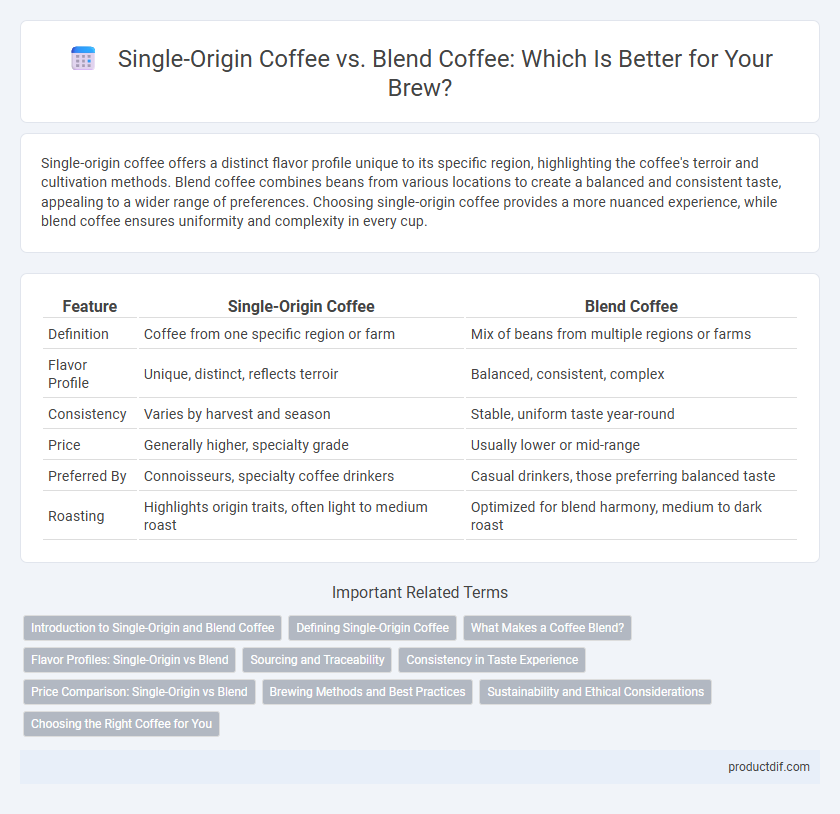Single-origin coffee offers a distinct flavor profile unique to its specific region, highlighting the coffee's terroir and cultivation methods. Blend coffee combines beans from various locations to create a balanced and consistent taste, appealing to a wider range of preferences. Choosing single-origin coffee provides a more nuanced experience, while blend coffee ensures uniformity and complexity in every cup.
Table of Comparison
| Feature | Single-Origin Coffee | Blend Coffee |
|---|---|---|
| Definition | Coffee from one specific region or farm | Mix of beans from multiple regions or farms |
| Flavor Profile | Unique, distinct, reflects terroir | Balanced, consistent, complex |
| Consistency | Varies by harvest and season | Stable, uniform taste year-round |
| Price | Generally higher, specialty grade | Usually lower or mid-range |
| Preferred By | Connoisseurs, specialty coffee drinkers | Casual drinkers, those preferring balanced taste |
| Roasting | Highlights origin traits, often light to medium roast | Optimized for blend harmony, medium to dark roast |
Introduction to Single-Origin and Blend Coffee
Single-origin coffee is sourced from a specific region, farm, or producer, offering unique flavors that reflect its geographical and environmental conditions. Blend coffee combines beans from multiple origins to create a balanced and consistent taste profile, often designed to enhance complexity and smoothness. Understanding these distinctions helps coffee enthusiasts appreciate the diverse characteristics and brewing potential of each type.
Defining Single-Origin Coffee
Single-origin coffee refers to beans sourced from a specific geographic location, such as a single farm, region, or country, which imparts unique flavor profiles influenced by local soil, climate, and altitude. This type of coffee offers distinct taste characteristics that highlight the terroir, often prized for its clarity and complexity compared to blends. Coffee enthusiasts prefer single-origin varieties for their traceability and the opportunity to experience diverse flavor notes that vary seasonally and by batch.
What Makes a Coffee Blend?
A coffee blend combines beans from different origins, roast levels, or varieties to create a balanced flavor profile that highlights complementary characteristics. Blending allows roasters to enhance complexity, consistency, and aroma by mixing beans with varying acidity, body, and sweetness. This technique contrasts with single-origin coffee, which emphasizes the unique terroir and distinct taste of beans sourced from a specific location.
Flavor Profiles: Single-Origin vs Blend
Single-origin coffee offers distinct flavor profiles that reflect the unique characteristics of a specific region, often featuring fruity, floral, or earthy notes influenced by local climate and soil conditions. Blend coffee combines beans from multiple origins to create a balanced and consistent flavor profile, often designed to highlight complementary tastes like chocolate, nuts, and caramel while minimizing acidity or bitterness. Coffee enthusiasts seeking complexity and distinct terroir typically prefer single-origin, whereas those favoring smooth, harmonious flavors often opt for blends.
Sourcing and Traceability
Single-origin coffee beans are sourced from a specific region, farm, or producer, enabling precise traceability and a transparent supply chain that assures authenticity and unique flavor profiles. Blend coffee combines beans from multiple origins, which can enhance complexity but often limits detailed traceability due to mixed sourcing. Consumers seeking transparency and origin-specific quality often prefer single-origin coffee for its clear sourcing information and direct producer relationships.
Consistency in Taste Experience
Single-origin coffee offers a unique and distinct flavor profile tied to a specific region, ensuring a consistent taste that reflects its terroir with subtle variations each harvest. Blend coffee combines beans from multiple origins to create a balanced and stable flavor, delivering consistent taste experience across different batches. For consumers seeking uniformity cup after cup, blends provide reliable consistency, while single-origin appeals to those valuing nuanced, traceable flavor differences.
Price Comparison: Single-Origin vs Blend
Single-origin coffee typically commands a higher price than blend coffee due to its unique flavor profile and limited production regions. Blend coffee, often more affordable, combines beans from multiple origins to balance cost and flavor consistency. Price differences reflect factors such as sourcing, rarity, and processing methods inherent to single-origin versus blend varieties.
Brewing Methods and Best Practices
Single-origin coffee highlights unique flavors specific to a single region, best brewed using pour-over or French press methods to preserve its distinct aroma and clarity. Blend coffee benefits from espresso or drip brewing, balancing multiple bean characteristics to create a harmonious taste profile. Grinding size, water temperature, and precise brewing time are critical best practices to optimize extraction and flavor for both single-origin and blend coffees.
Sustainability and Ethical Considerations
Single-origin coffee often supports sustainability by promoting direct trade relationships with specific farms, ensuring better wages and environmentally friendly practices. Blend coffee, while offering consistent flavor, may involve sourcing from multiple regions with varying sustainability standards, making ethical verification more complex. Consumers seeking transparency and ecological responsibility typically prefer single-origin options for their traceability and support of smallholder farmers.
Choosing the Right Coffee for You
Single-origin coffee offers distinctive flavors tied to specific regions, highlighting unique tasting notes caused by local climate and soil conditions. Blend coffee combines beans from multiple origins to create balanced profiles, enhancing consistency and complexity. Choosing the right coffee depends on whether you prefer the nuanced complexity of single-origin or the harmonious flavor of blends.
Single-origin coffee vs Blend coffee Infographic

 productdif.com
productdif.com